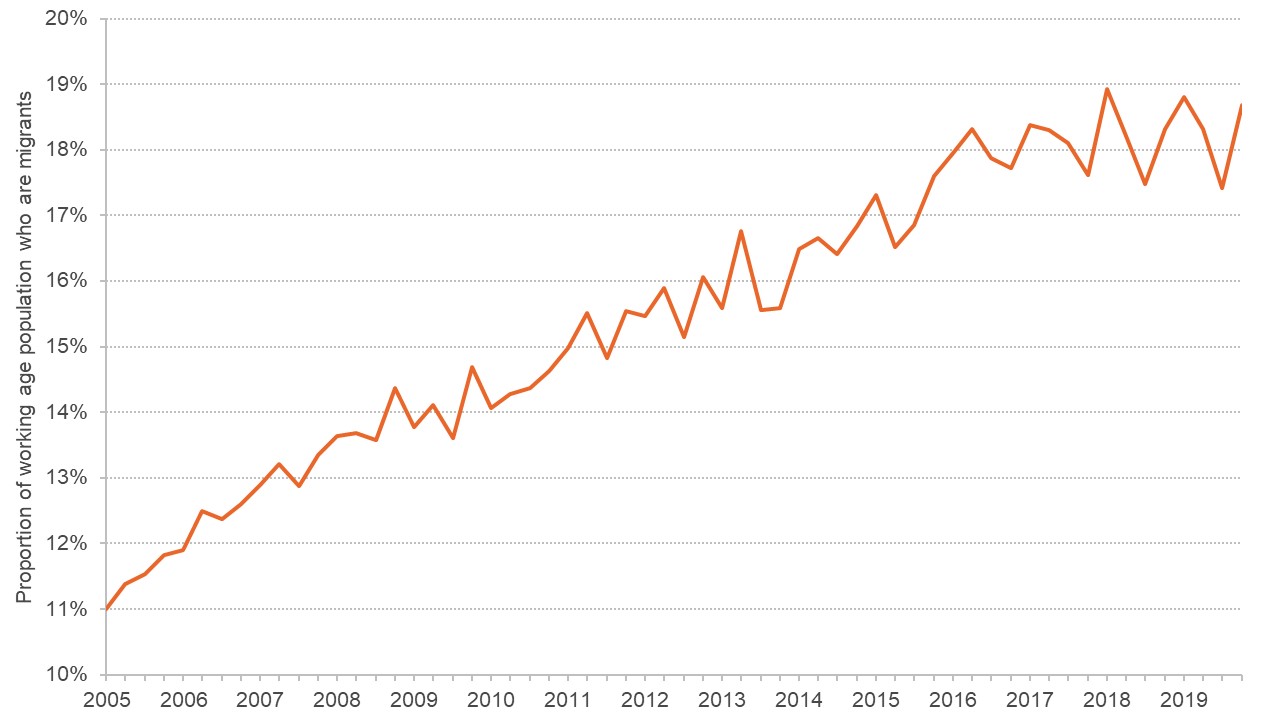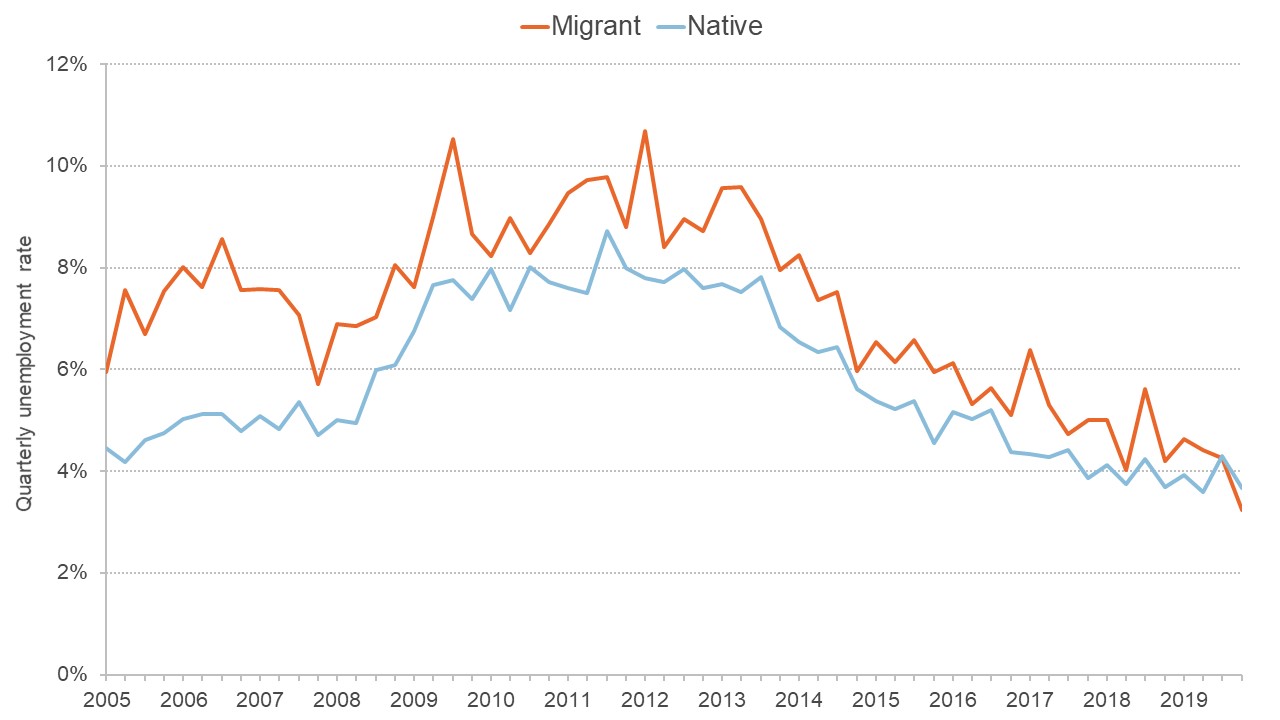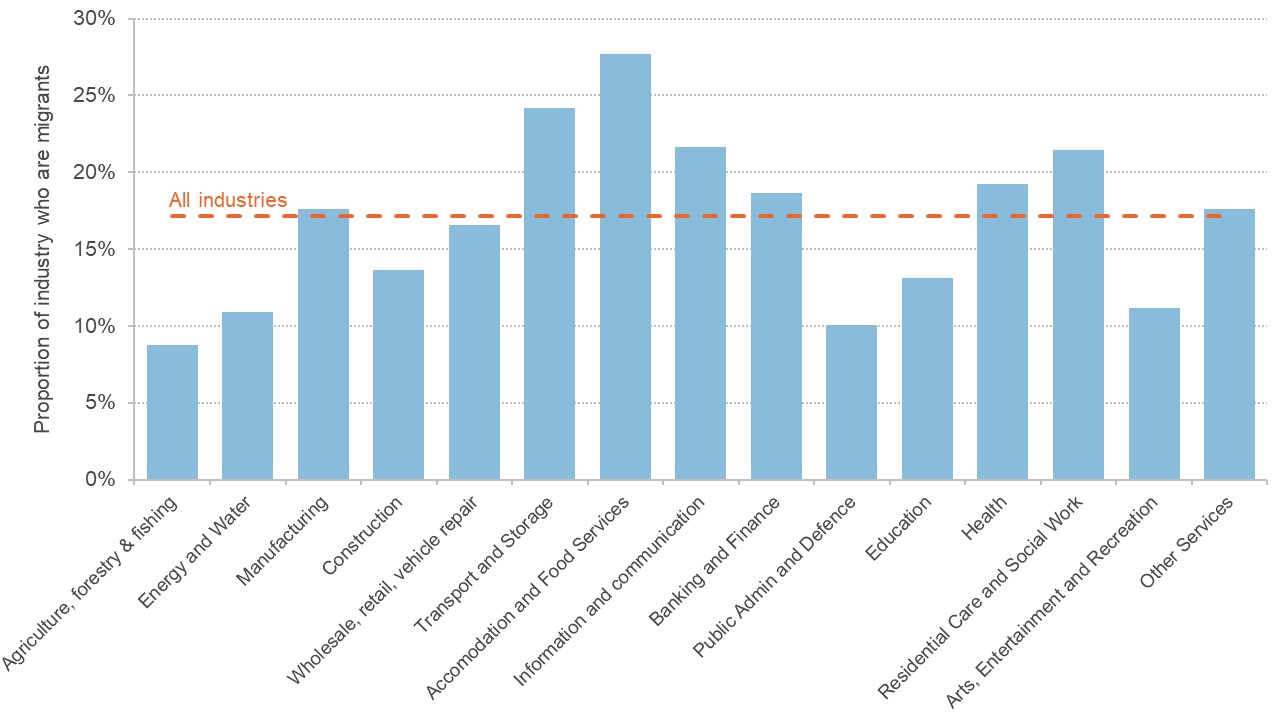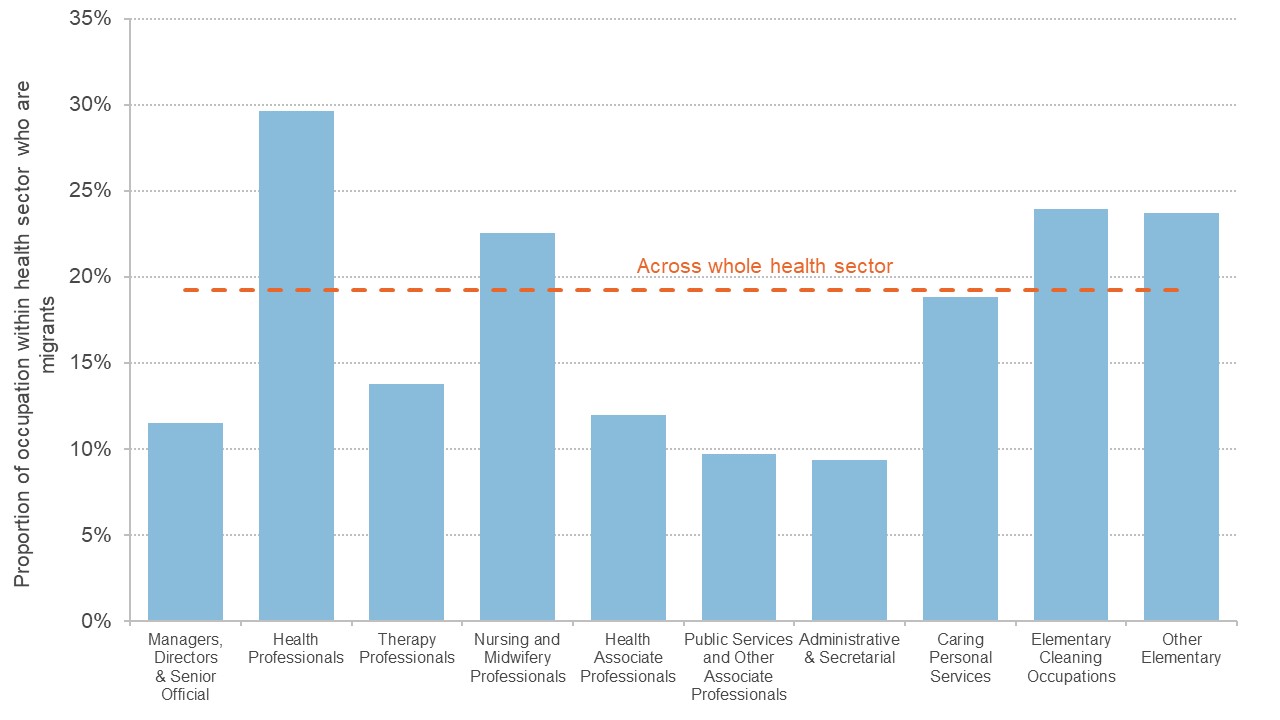Recessions have an impact on net migration flows, the labour market outcomes of migrants and the effects of migrants on native outcomes. Migrant workers face particular challenges in the Covid-19 crisis given the industries and occupations in which many of them are employed.
Public concerns about immigration have played a major role in recent political events and elections. From an intuitive point of view, immigration can have both positive and negative effects on other workers. While migrants can potentially compete with natives for the same jobs, they might also increase productive activities by bringing in new skills or ideas, or by increasing demand for goods and services.
During the Covid-19 recession, it is possible that any concerns about migration become exacerbated – in which case, a reasoned debate based on evidence is more important than ever.
Related question: What will be the impact of Covid-19 on public attitudes to immigration?
What does evidence from economic research tell us?
A recent overview of research on migration in the UK concludes that immigration has: no effect on unemployment; an overall positive/insignificant impact on native wages; a small and negative impact on the wages of low paid/unskilled native workers; and a positive effect on productivity, per capita GDP and net fiscal contributions (Portes, 2018). Further research shows that during recessions, it is possible for these results to vary:
- Net migration is still positive but at a reduced rate during a recession (see Office for National Statistics, ONS, data).
- Over the business cycle, the unemployment rate for migrants tends to have a more volatile response than the rate for natives. But in the UK, this difference mostly arises during an expansion and not in a recession (Dustmann et al, 2010).
- During a recession, migration has a small negative effect on native unemployment, whereas during an expansion, there is no effect in the UK (Migration Advisory Committee, 2012).
- Migrants can allow natives to specialise in occupations with more complex communicative/interactive tasks, which can improve overall productivity. This specialisation effect slows down during a recession (D’Amuri and Peri, 2014).
- Within currency unions, migration helps local economies to absorb asymmetric shocks and reduces fluctuations in native employment (D’Amuri and Peri, 2019; Cadena and Kovak, 2016).
What is the evidence and how reliable is it?
Migrant flows in recessions
During a recession, net migration is still positive but at a reduced rate. In the UK, this has been found to be the case in recessions before 2007 (Dobson et al, 2009) and during the 2008/09 recession, when migration growth fell from 6.6% in 2007/08 to 4.4% in 2008/09 (Tilly, 2011).
The UK experienced changes in the composition of migrants’ countries of origin during the 2008/09 recession. The biggest decrease was registered for national insurance registrations from the 12 countries that joined the European Union between 2004 and 2007, mainly from Eastern Europe. (Clark et al, 2016). In addition, by 2009, around half of the workers who had come to the UK since 2004 had left. Despite this, migration from other countries continued to increase during the recession (Fix et al, 2009).
Effects on migrants
Migrants have more volatile unemployment responses than natives over the business cycle. In the UK, this is mainly driven by differences during expansions. One study finds that in the UK over the period from 1982 to 2005, the unemployment rate for migrants was more volatile than that of natives (Dustmann et al, 2010).
The authors of this study also find that non-OECD migrants have a more volatile response to the business cycle than OECD migrants. In UK recessions over the period from 1981 to 2005, changes in unemployment rates are similar, whereas migrants respond more strongly than natives during expansions. Over a similar time period in Germany, by contrast, migrants’ unemployment response is stronger than natives in both recessions and expansions.
Research has not reached a consensus on whether a recession affects migrant and native wages differently, perhaps because of differences in the research methods used. One study finds that the business cycle affects migrant and native wage volatility the same in the UK and Germany (Dustmann et al, 2010).
Since migrants tend to cluster in both less essential and more vulnerable occupations, recessions may not affect migrants equally across all occupations (Tilly, 2011). Many migrants are employed in highly cyclical occupations, which are vulnerable to recessions, such as construction, manufacturing and hospitality. But many migrants are also employed in essential industries and occupations that are less vulnerable to recessions, such as social care, healthcare work, domestic work and agricultural work.
Furthermore, recent work in light of Covid-19 finds that in the UK, 16.1% of essential workers across all industries are migrants (Fernández-Reino et al, 2020).
Effects on native workers
Although there are many peer-reviewed studies of the impact of migration on a wide range of outcomes, research on the effects during recessions is more scarce and often based on policy reports.
The impact of migration on native unemployment tends to be negative during a recession but has no effect during an expansion. For the UK, a policy report finds significant negative effects during a recession and no significant effect during expansions (Migration Advisory Committee, 2012).
Some of the negative effects of migration during recessions can potentially be explained by natives being less able to specialise during downturns. In line with research from other countries, it has been found that in the UK, less educated natives often respond to migrant inflows by specialising in more communicative tasks (Bisello, 2014). Evidence from other countries shows that this specialisation process can slow down during a downturn (D’Amuri and Peri, 2014).
The effect of negative shocks that do not affect each area of the country equally can be mitigated via increased migrant mobility. Research finds that increased migrant mobility helps local economies to absorb asymmetric shocks and reduce the fluctuation of native employment rates during these local downturns (Basso et al, 2019; Cadena and Kovak, 2016).
Evidence from the ONS
Using Quarterly Labour Force Survey data, Figure 1 plots the proportion of individuals aged 16-64 who are migrants. The overall positive trend only slows (and does not reverse) during the recession of the late 2000s and after the Brexit referendum in 2016.
Figure 1: Proportion of the working age population who are migrants.

Source: Quarterly Labour Force Survey 2005-2019
The unemployment rates in Figure 2 for natives and migrants aged 16-64 show that, on average, migrants suffer higher unemployment rates. While the gap in unemployment widened during the recession of the late 2000s, the subsequent period has seen a narrowing of unemployment rates. In fact, by 2019, the unemployment rates of natives and migrants were indistinguishable.
Figure 2: Quarterly unemployment rate by country of birth, 2005-2019

Source: Quarterly Labour Force Survey 2005-2019
What further evidence is needed?
Evidence is needed on how the impact of migration on outcomes such as native wages, productivity and fiscal effects changes in the short run during a recession. In addition, more comprehensive evidence on the impact of migration on native unemployment during a recession would be beneficial.
Evidence on how migration affects the ability of a country to recover from a recession is needed. This would allow policy-makers to understand at what point in the business cycle migration policy should become more open versus more closed.
Why might the Covid-19 recession be different from previous ones?
The Covid-19 recession is likely to affect a wider range of sectors; in many of these, migrants constitute a large percentage of the workforce. The key discussion occurring in economics on the difference between the Covid-19 recession and previous recessions centres on sectors that are heavily affected by social distancing measures (Mathy, 2020).
Furthermore, research suggests that this recession will not be concentrated in markets for housing and lending, but in a wide range of sectors including accommodation and food, real estate, business and administration, manufacturing, wholesale and retail, vehicle repair, transport, storage and communication, arts, entertainment and recreation (Mayhew and Anand, 2020).
Figure 3 shows the proportion of migrants in the workforce by industry in the period from 2015 to 2019. The horizontal orange line shows the proportion of migrants across all industries: just above 17%. Industries above this orange line are those with a higher proportion of migrants than average. Sectors with a particularly high proportion of migrants are transport and storage, accommodation and food services, information and communication, and residential care and social work, all with over 20% of the workforce being foreign-born.
This could have important implications for the Covid-19 recession and subsequent recovery. Since many of these industries are likely to suffer disproportionately from a Covid-19-induced crisis, it is possible that migrant workers will experience particularly high unemployment rates.
Related question: How is the crisis affecting inequality across ethnic groups?
Figure 3: Proportion of workers within an industry who are migrants, 2015-2019

Source: Labour Force Survey 2015-2019
Migrants make up a large percentage of healthcare sector workers across a wide range of occupations. Figure 3 shows that 19% of workers in the sector are migrants. The healthcare sector has been essential in the response to the pandemic and it will continue to be important as the UK economy tries to recover before a vaccine can be created.
Figure 4 breaks down the healthcare sector into key occupations (where we consider only occupations with more than 1% of sector workers). It shows the proportion of workers in an occupation who are migrants for the years from 2015 to 2019. Again, the horizontal orange line denotes the proportion of migrants in the sector overall: around 19.2%. This shows that migrants are an essential part of this sector: 30% of healthcare professionals; and 23% of nurses and midwifes.
Furthermore, migrants are a large part of the lower paid occupations within this sector, where they make up 19% of caring personal services and 24% of cleaning occupations (and other elementary occupations). Unlike previous recessions, a strong economic recovery will require a continuing strong healthcare sector and migrants will be essential to this.
Figure 4: Proportion of occupations within the health sector who are migrants, 2015-2019

Source: Labour Force Survey 2015-2019
What research is under way?
The Centre for Research and Analysis of Migration (CReAM) carries out high quality, cutting edge and non-partisan research on migration.
The Migration Observatory provides a good overview of statistics on migration.
Where can I find out more?
What do we know about migration? Informing the debate: CReAM provides a wide-ranging policy briefing on the impact of migration in the UK.
The economic impacts of immigration to the UK: Jonathan Portes provides an accessible summary of the impact of migration in the UK.
Labour mobility and adjustment to shocks in the euro area: the role of immigrants: Gaetano Basso, Francesco D’Amuri and Giovanni Peri provide an accessible summary of their work on how migrants can mitigate local shocks.
Immigrant key workers in Europe: the Covid-19 response that comes from abroad: Francesco Fasani explores the role of migrants as key workers and what this means for policy-makers.
Who are experts on this issue?
- Christian Dustmann, University College London
- Uta Schoenberg, University College London
- Jonathan Portes, Kings College London
- Giovanni Peri, UC Davis









































